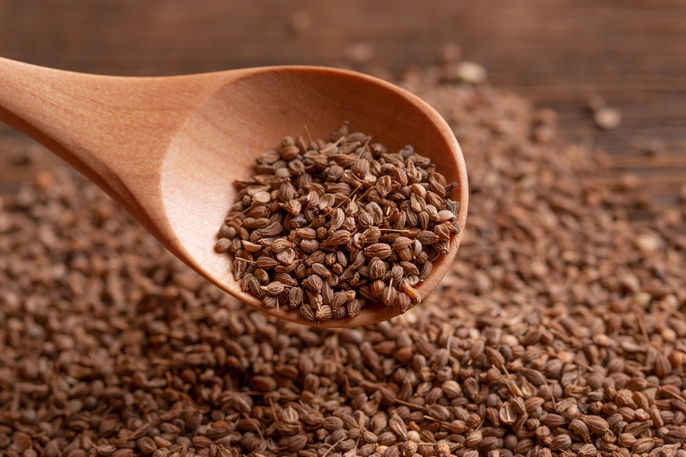Star anise is a spice made from the fruit of Ilicium verum, an Asian tree. This spice is usually found in its dried form, and can be purchased at grocery stores or natural health stores.
Star anise is widely used in cooking to add a sweet flavor to dishes, but it can also be used to achieve health benefits, as it contains compounds like anethole.
Star anise is sometimes confused with green anise, which is commonly called fennel, however they are different medicinal plants. Read more about fennel and the health benefits associated with this plant.

Health benefits
Star anise can offer health benefits such as:
1. Preventing the flu
Star anise is a natural storehouse of shikimic acid, which is a substance that is used in the pharmaceutical industry to produce the antiviral drug oseltamivir, better known as Tamiflu [1,2,3]. This drug is used to prevent and treat infections by Influenza A (H1N1 and H3N2) and Influenza B viruses [2], which are responsible for the flu.
Regularly consuming star anise as an added spice or as a tea is great, natural way to prevent the flu [3], especially during cold and flu season.
2. Fighting fungal infections
Star anise is high in anethole, which is effective for the treatment of several types of microorganisms, including fungi. According to some studies, star anise extract can inhibit the growth of fungi like Candida albicans, Brotytis cinerea and Colletotrichum gloeosporioides.
3. Eliminating bacterial infections
In addition to its anti-fungal action, the anethole that is naturally found in star anise also prevents the growth and spread of bacteria. Lab studies have shown that this medicinal plant is effective for the elimination of bacteria like Acinetobacter baumannii, Pseudomonas aeruginosa, Staphylococcus aureus and Escherichia coli. These bacteria are responsible for various types of infections, such as gastroenteritis, urinary tract infections and skin infections.
In addition to anethole, studies indicate that other substances present in star anise, like anisic aldehyde, anisic ketone or anisic alcohol, can also contribute to its antibacterial action.
4. Strengthening immunity
Like many aromatic plants, star anise has a potent antioxidant action due to the presence of phenolic compounds in its composition. Although some studies have shown that the antioxidant power in star anise may be lower in comparison to other aromatic plants, it can still be used to boost immunity. Star anise's properties may be able to eliminate free radicals that interfere with optimal functioning of the body.
This antioxidant action has also been linked to a reduced risk of developing cardiovascular diseases and cancer.
5. Eliminating and repelling insects
Some studies done on star anise essential oil have shown that this spice contains insecticidal and repellent action against some types of insects. Its action against fruit flies, German cockroaches, beetles and even small snails has been confirmed in lab settings.
6. Promoting digestion and treating gas
Star anise has a carminative and anti-inflammatory effect. It can be consumed after very heavy and fatty meals, to promote digestion and prevent the accumulation of gas in the stomach and intestines.
Some studies also shown that star anise consumed together with chamomile can help to treat diarrhea.
Difference between fennel and anise
Fennel and anise are very similar are are easily confused for each other. Although they are very different plants, they contain similar compounds and properties.
Fennel contains thinner leaves, yellow flowers and longer seeds than anise.
Anise is a plant with white flowers, wide leaves and smaller, rounder seeds.
How to use
The most common way to use star anise is to add it as a spice in sweet or savory dishes. It can also be obtained in the form of essential oil for the use of aromatherapy or for inhalations.
Many substances are extracted from star anise to be used for in medications, cleaning products, beauty products and even toothpaste.
How to make anise tea
Anise tea can be used to relieve headaches and cold and flu symptoms, like coughing, runny nose and phlegm.
Ingredients:
- 1 teaspoon of dried anise seeds
- 1 cup of water
How to prepare:
Smash or chop the anise seeds. Boil the water and remove from heat. Pour the water into a cup and add the anise teas. Cover and soak the seeds for 10 minutes. Then strain and drink. You can drink up to 3 cups of this tea per day for up to 2 weeks.
Possible side effects
Star anise is considered to be safe, especially when used as a spice in your dishes. However, drinking excessive amounts of star anise tea can lead to contact dermatitis and nausea. Star anise essential oil applied directly to the skin may also lead to skin irritation.
Contraindications for use
Star anise is contraindicated for people with hyperestrogenism, hypersensitivity, pregnant women, women who are breastfeeding and children, as no studies have been done on the medium and long-term effects of star anise use in this population.






























